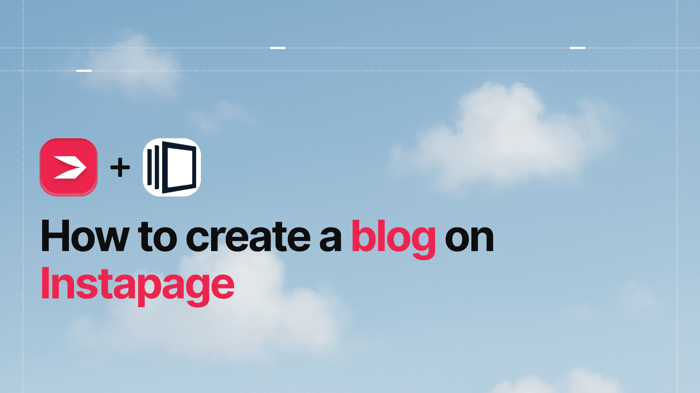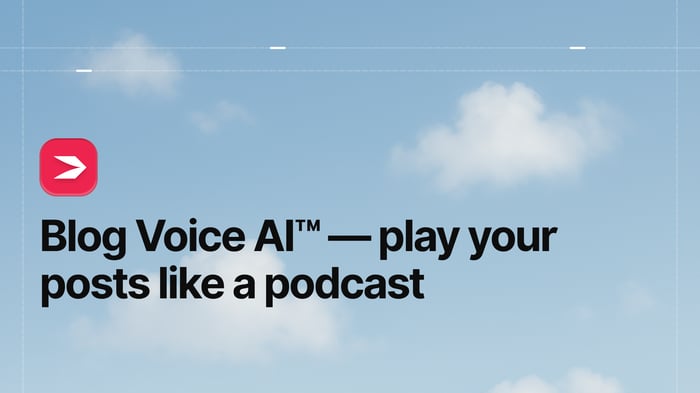Instapage and Unbounce are currently among the most popular landing page builders on the market. Some basic stats show that Unbounce has the edge over Instapage regarding monthly visits, average visit duration, pages per visit, and bounce rates. Furthermore, the fact that Instapage was launched in 2012 while Unbounce started in 2009 implies that Unbounce is the more experienced company, which can be another big plus. However, there’s so much more to these platforms than just those numbers.
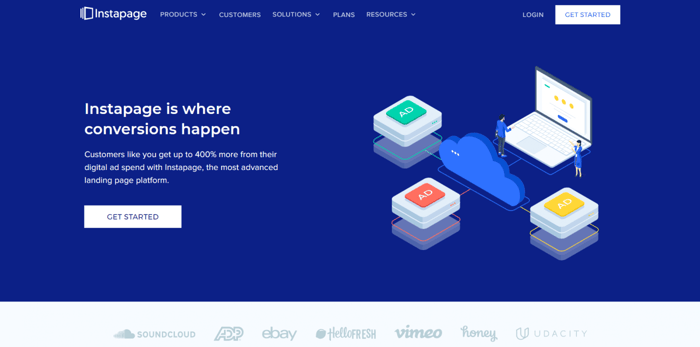
Instead of just focusing on stats, we need to take a closer look into each of the platforms, explore how they work and who they’re best for, and only then make conclusions about whether they’re worth our time and effort.
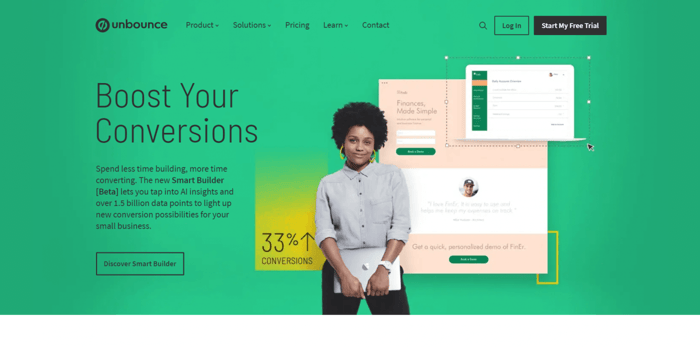
In this Instapage vs. Unbounce comparison, we’ll go over some of the key components that make up these two systems and the most important aspects of the services they offer. So, let’s get this show on the road!
Table of Contents
Pricing
Instapage
The Instapage Pricing System
Instapage offers a pricing system that’s pretty simple and straightforward, but at the same time, a bit limiting. It consists of only two pricing plans, titled Building and Converting. The following image shows some of the specifics about the Instapage pricing plans:
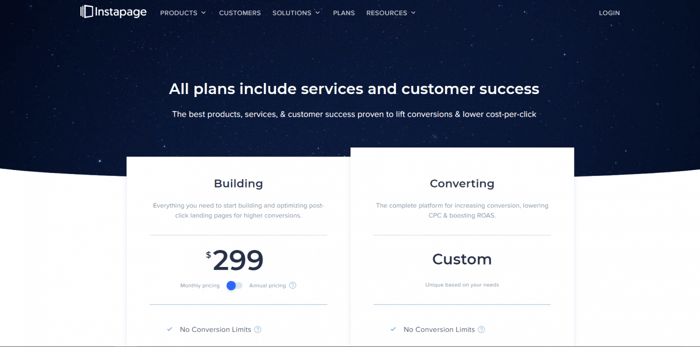
As you can see, Instapage offers two types of billing: monthly and annual. As usual, an annual subscription means a discounted price. In case you like Instapage and opt for the annual pricing, you need to pay $2,388/year which is the same as paying $199/month instead of $299/month. Clearly, there’s a huge advantage to it, so if you can afford the upfront costs, it’s a much more economical choice.
Instapage doesn’t offer a free plan, but there’s a 14-day free trial to kick the tires of the Building plan. To sign up for the trial, you need to leave your credit card information. Additionally, you can schedule a demo of the Converting plan.
The Building Plan
Besides unlimited conversions, the Building plan allows a maximum of 30,000 unique visitors per month as well as 30 published landing pages. For team collaboration, there are features like three workspaces and three team members.
From the list of other Building plan features, we can single out the following:
- Split testing
- Thor Render Engine
- AdMap
- AMP landing pages
- Postclick score
We’ll talk about these notable tools in the following section. For now, it’s important to just know that they’re all available with the Instapage Building plan.
The Converting Plan
Due to it being a custom plan, certain aspects of the Converting plan are a matter of agreement such as custom integrations (you ask for certain extensions and the platform adds them to your toolkit) and custom feature implementation (similar to custom integrations). As far as other perks of this plan are concerned, here are three features that are available only with the Converting plan:
- Heatmaps
- Multi-step forms
- 1:1 Ad-to-Page personalization
We’ll explore these later in a separate subsection on notable Instapage features.
Unbounce
The Unbounce Pricing System Overview
The Unbounce pricing system includes a 14-day free trial and four pricing plans, all paid:
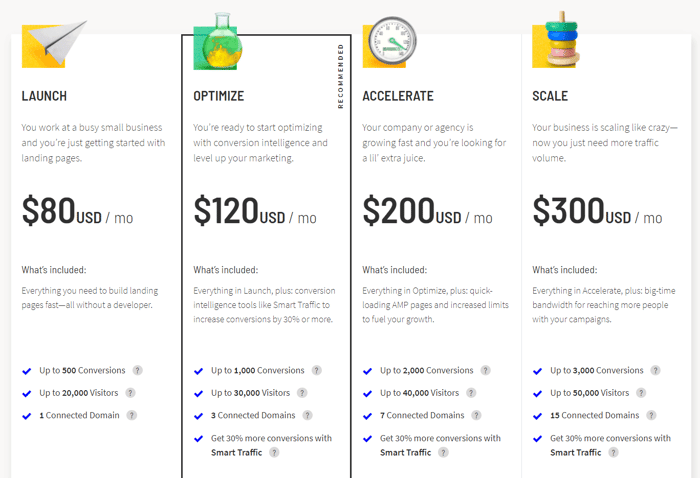
This image shows the fees for the monthly subscriptions. With the 10% discount on the annual subscriptions, the prices are the following:
- Launch: $864/year, equivalent to $72/month
- Optimize:$1,296/year, equivalent to $108/month
- Accelerate: $2,160/year, equivalent to $180/month
- Scale: $3,240/year, equivalent to $270/month
In addition to the standard pricing plans, Unbounce offers so-called Concierge plans. These are custom plans with the advantage of higher limits on variables like conversions and unique visitors as well as exclusive, dedicated expert support.

You can’t test a Concierge plan via the regular 14-day free trial. Instead, you have to book a demo and learn exactly how they differ from the standard plans.
Notable Pricing Plans Features
Besides the features shown in the image with the summed up Unbounce pricing plans, Unbounce gives you access to the following tools as well:
1. The Launch plan:
- Smart Builder
- Real-time analytics
- Popups and sticky bars
- Speed boost
2. The Optimize plan:
- Smart Traffic
- Split testing
- Dynamic text replacement
3. The Accelerate plan:
- AMP landing pages
As for the Scale plan, apart from the higher number of conversions, traffic, and domains, it’s identical to the Accelerate plan.
Whose Pricing System Is Better?
The answer to this question depends on many variables, including some strictly personal factors like whether a platform provides the exact functionality that you need or want. However, this doesn’t mean that there’s no way to ever be objective about an Instapage vs.Unbounce pricing comparison.
More Pricing Options Is Better
A huge pro for the Unbounce pricing system is – as we suggested before – that it includes more pricing plans than Instapage. A wider range of options is usually preferred as long as it’s not over the top and overwhelming, and there’s nothing overwhelming about the Unbounce plans. This platform allows you to choose between multiple packages, depending on the stage of your business development and your real needs, thus catering to more users and types of audiences, which is pretty neat.
Landing Pages and Conversions
Unlike Instapage, all Unbounce plans include unlimited landing pages. However, in contrast to the unlimited conversions in the Instapage Building plan, Unbounce gives you a limited number of conversions, regardless of the plan you choose. So, Unbounce has the upper hand regarding the number of landing pages, but it lags behind Instapage as far as the number of conversions is concerned.
If you need more landing pages, Unbounce is the better option. If more conversions are what you’re looking for, you should consider Instapage.
Traffic
Regarding the most basic features, another difference is in the maximum unique visitors allowed every month.
We saw that the Instapage Building plan offers 30,000. With Unbounce, you get the same number with the Optimize plan, but the difference in price is huge. While you pay $120 per month for the Unbounce Optimize plan, with the Instapage Building plan you need to shell out almost $300 for the same number of visitors.
Overall, when it comes to traffic, Unbounce is better considering that it offers a wider range of options and you can get more for less or the same amount of money.
Facts and Presumptions
For the sake of objectivity, it’s just a fact that Instapage is very pricey while Unbounce can be pretty affordable, especially for users who are at the beginning of their online business adventure.
Even Instapage customers share the opinion that the platform is a bit on the expensive side. If you check customer reviews on a website like Capterra, you’ll see that the bulk of the Instapage customers think that the platform’s prices are pretty steep – even those who are there for a reason and like what the platform offers.
Presumably, one of the reasons for the difference in prices is that Instapage seems to be geared toward more advanced and experienced users. Generally, it’s considered that Instapage includes relatively advanced tools and it can be of great convenience to marketers who are well-versed in PPC (pay-per-click) marketing.
In contrast, Unbounce offers simpler tools that would work well for beginners in the niche, hence the low-priced plans catering exactly to this category of users.
Cost-Effectiveness
One very important thing about any platform is how cost-effective it is. This can be very different from whether it is affordable or not. An expensive service can be much more cost-effective than a low-priced service of the same type. If the expensive one is super-effective, convenient, works smoothly, and enables you to achieve your goals, then it’s absolutely cost-effective. On the other side of the spectrum, if the low-priced service is plagued with bugs, inconveniences, interruptions, and whatnot, it’s not worth using it.
Measuring cost-effectiveness requires hands-on experience and knowledge of a platform’s features. We can’t provide the first, but we can help you with the second.
Important Features
Instapage
Split Testing
Split or A/B testing is a widespread practice of building two (or more) versions of a landing page. The objective is to test them out with real users, see how they perform conversion-wise, and then use the one that gives better results.
It’s recommended not to have more than one difference between the page versions. The rationale behind this recommendation is that having only one difference (or at least as few as possible) makes it easier to see the exact cause for the better performance of the more successful page version.
You can’t exactly test every aspect of your landing page. Some of the things you can, though, are the following:
- CTA (Call-to-Action)
- Page layout
- Page length
- Headlines
For a more in-depth review of split testing, check out this Instapage article.
Thor Render Engine
The Thor Render Engine is Instapage-developed software that’s all about high-speed page loading.
It’s common knowledge that page speed can seriously affect any business, both positively and negatively. Due to their purpose of attracting and converting leads, fast load time is crucial for landing pages. You can hardly expect to boost those conversion rates if users have to wait just to see what you offer on your landing page, let alone interact with it.

Without a render engine, pages would be reduced to plain text files. The Thor Render Engine is the silent background mechanism that renders the rich content and styles that users see on the Instapage-built and hosted landing pages. Thanks to techniques like resource prioritization, JavaScript code optimization, and CSS refactoring, the Thor Render Engine allows users to experience extremely fast, responsive pages, which is one of the deciding factors for success in the conversion context.
AdMap
AdMap is a tool that allows you to develop a personalized marketing approach to your audience.
As a prerequisite, you need to link your Google Ads and Instapage accounts together. AdMap will allow you to connect different search campaigns with different landing pages on Instapage. In this way, by showing different page content to different visitors and types of audiences, AdMap enables you to create personalized ad experiences for your audience.

AMP (Accelerated Mobile Pages) Landing Pages
Instapage introduced this feature in 2018. It was an upshot of a successful collaboration with Google.
Accelerated Mobile Pages are, as their name suggests, high-speed mobile pages. The AMP landing pages are the result of general efforts to speed up mobile pages to the point where they would have lower bounce rates. According to a study carried out by Google and SOASTA, a load time longer than three seconds ends with 40% of the users leaving the page.
This is devastating news for any business built on technology that doesn’t follow the current recommended practices as far as page speed is concerned. It’s especially important in today’s context, where more users than ever before access the internet via their mobile devices. Luckily, Instapage doesn’t lag behind on this front. For more on the specifics of how it achieves this, see this article.
Postclick Score
Instapage is all about personalized user experience and the Postclick Score is the value that shows the ratio between your ads and what Instapage calls “unique landing page experiences” – another way of saying personalized landing pages.
High Postclick Score goes hand in hand with high personalization. The ideal ratio is one landing page to one ad, which means maximally personalized and relevant content. Instapage calculates this score and gives you insight into how close you are to the ideal value.
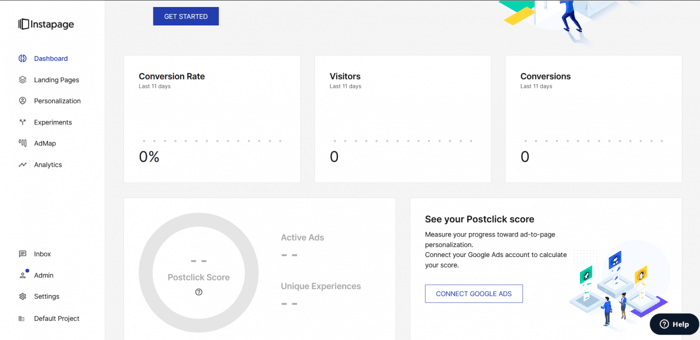
Heatmaps
Heatmaps on Instapage are a data visualization tool that allows you to track the interaction between your audience and your landing pages. Thanks to the insights from the heatmaps, you can learn which facets of your landing page need adjustments as well as how to adjust them for higher conversion rates.
Multi-Step Forms
Multi-step forms are long forms divided into multiple parts where each part is a new step in the information-gathering process. Usually, it starts by asking only for the basic user information (full name, email address, or similar) and proceeds by collecting additional information in the following steps.
The whole point of this approach is to avoid discouraging users by the length of the form. A long form that is not broken down into several steps can be a visual nightmare for many users and easily deter them from sharing their precious personal information with you.
1:1 Ad-to-Page Personalization
This is yet another feature that’s the result of Instapage’s dedication to creating personalized marketing experiences. It’s closely related to some of the features we already explored.

1:1 Ad-to-Page personalization gives you the ability to dynamically deliver different content and styles according to the specific user who’s visiting your page. This means that the same landing page can look (slightly) different to 10 different users, depending on their profile and personal preferences.
Unbounce
Smart Builder
The Smart Builder is Unbounce’s proprietary software. It’s still in its beta phase, but it’s definitely worth trying.
Like any other landing page builder, the Smart Builder enables you to create and customize landing pages. In that sense, there’s nothing special about it. What makes it stand out from its competition is the AI-based system that it utilizes to help you create pages optimized for conversion.
The Smart Builder is data-driven software. It relies on collected information on more than 1.5 billion conversions and gives you suggestions on how to build a conversion-optimized landing page. The best part is that this happens during the very process of building, before you even publish your page.
You can see it in action without even signing up for a free trial. Unbounce offers an interactive demo so you can conveniently explore the Smart Builder for free.
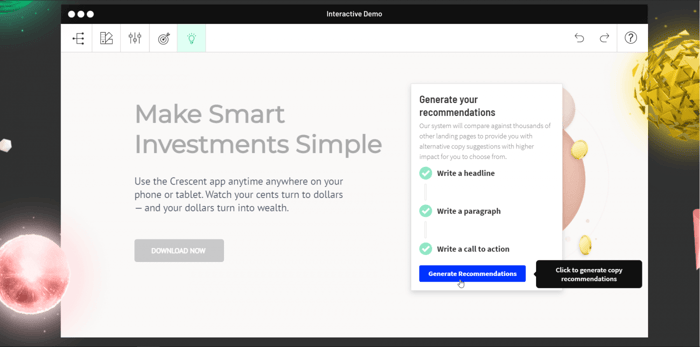
Popups and Sticky Bars
Popups and sticky bars can be a convenient way to offer your products or services to users. Depending on their design and content as well as how unintrusive they are, they can significantly contribute to higher conversion rates.
Unbounce provides you with the opportunity to create and customize popups and sticky bars and optimize them for conversion. It’s interesting that you can transform a popup into a sticky bar for mobile devices. This can enhance mobile users’ experience and, thus, help you with SEO.
Different events can trigger popups and sticky bars, like a visitor entering a page, scrolling up, clicking somewhere, exiting the page, etc. While popups sometimes look like they show up from nowhere only to usurp the central part of your visual field, sticky bars are much less intrusive. Normally, they show up either at the top or at the bottom of a page and make it easier to convey a message to a page visitor in a more meaningful way.
Real-Time Analytics
Unbounce offers an analytics dashboard that gives you insight into stats like conversions, conversion rate, and traffic in real time. You can even track data on popups and sticky bars.
Additionally, you can add third-party software like Google Analytics and Facebook Pixels for more analytics options.
Speed Boost
According to Unbounce, "for every second of load time, your conversions drop by 12%.” That’s why Unbounce follows the current best practices and Google’s recommendations regarding page loading and speed. It takes care of all the technicalities that make a landing page load fast to ensure that its customers’ landing pages provide the best possible user experience, which eventually leads to higher conversion rates.
Some of the techniques and tools Unbounce uses to achieve the desirable lightning-fast page speed are the following:
- JavaScript code/files minification
- CSS optimization
- Content prioritization
- Image optimization
- SVG graphics support
- CDN (Content Delivery Network)
Smart Traffic
Smart Traffic is a brilliant AI-based tool developed by the Unbounce team. It’s the Unbounce version of the personalized-experience approach prevailing at Instapage.
Essentially, Smart Traffic is a machine learning algorithm that allows you to create personalized landing page experiences for your audience. It works by categorizing users into different groups, so members of different categories see different versions of a landing page. More precisely, every user sees the version that’s most likely to convert.

The Smart Traffic differs from split testing in that its objective is not to single out one champion landing page version for future use. Instead, you create multiple variants and the Smart Traffic forwards traffic to each of them based on its calculation of which one is the most suitable for whom.
Another difference is that as it’s powered by artificial intelligence and machine learning, it never stops learning and improving itself. Hence, over time, you get even better results than when you first started using the tool.
For an in-depth explanation of exactly how this software works, check out Unbounce’s article "What Is Smart Traffic?"
Split Testing
This is the same feature we saw at Instapage. There may be certain subtle differences in how different platforms implement this technology, but in essence, it’s the same functionality wherever you encounter it.
Dynamic Text Replacement (DTR)
This is another marketing personalization tool in Unbounce’s toolkit.
Dynamic text replacement or DTR is a tool that allows you to modify the text/message of an ad and landing page based on a user’s search keyword. It aims at showing the most relevant text/message to every user. This means that different users see slightly different ads and landing pages, depending on what they need and search for.
Unbounce lets you use DTR in multiple contexts: email campaigns, Google Ads, Facebook Ads, and Bing Ads.
AMP Landing Pages
The same things we said earlier about this feature at Instapage apply here as well. So, if you wonder whether Unbounce allows you to take advantage of the fact that gazillions of users around the globe surf the internet on their mobile devices, you should know that Unbounce has got you covered all over and ensures that slow page load times don’t afflict your business.
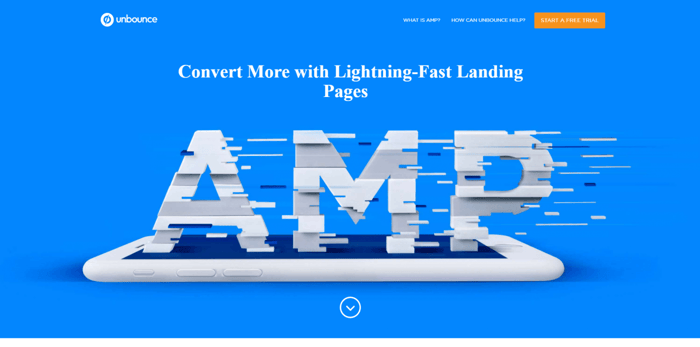
Whose Features Are Better?
Without exaggeration, this is an extremely hard question to answer. We like the Celtics, you like the Lakers. We think Jordan is the GOAT, you think it’s LeBron.
Not everything about these two platform’s features is subjective, but it’s not that easy to spell out how things stand objectively. So, we leave it to you to take Instapage and Unbounce for a spin and see how they compare against each other in terms of features.
Integrations
Instapage
Official Integrations
With more than 120 official integrations, Instapage offers a wide array of possibilities to extend the range of its out-of-the-box functionality.

The official integrations are divided into categories and types. There are 11 categories, based on the apps’ use case (marketing automation, e-commerce, CRM, advertising, call tracking, etc.) and four types, based on how they integrate with the Instapage software (native, custom code, enabled via Zapier, and enabled via webhooks). Currently, one of the types – the custom code integrations – is an empty set.
HubSpot, ActiveCampaign, MailChimp, ConvertKit, Salesforce, Shopify, Stripe, PayPal, Google Analytics, Google Ads, Facebook Ads, LiveChat, and Zapier make only a fraction of the complete list of Instapage integrations.
More Integration Options
Besides the official integrations, you can add third-party software to Instapage through embed codes. It's an option available with both pricing plans. With this method, you can add functionalities that are completely missing from the list of official integrations, such as a blog. For instance, Instapage lets you add a fantastic modern blogging tool like DropInBlog easily through embed codes.
For more on this method, the possibilities it brings to the table, and blogging with Instapage, see "How to Create a Blog on Instapage."
Unbounce
Official Integrations
The list of official Unbounce integrations includes about 120 apps, which means that Unbounce is on a par with Instapage in this regard.
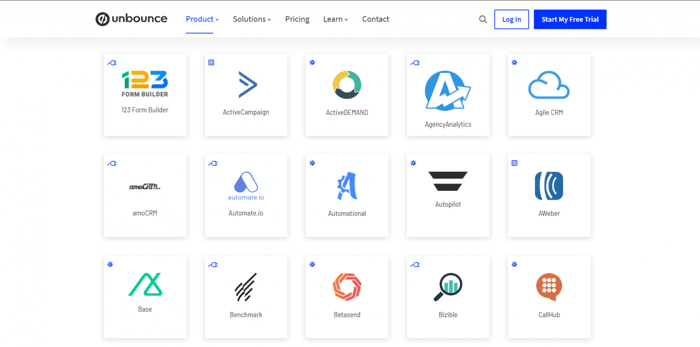
These integrations are split into twelve categories, according to their use (analytics, optimization/testing, webinar, marketing automation, CRM, etc.) and three types, according to how they integrate with Unbounce (in-app integrations that come built into Unbounce, Zapier-available integrations, and compatible integrations, which means they’re not built-in, but you can add them to Unbounce).
The list of noteworthy Unbounce integrations includes AWeber, Automate.io, Hotjar, Infusionsoft, Marketo, Pardot, and many more that can be found at Instapage as well.
Other Integrations
Unbounce allows the use of embed codes via the Custom HTML feature as well. This, of course, means that what we said about the embed code method in Instapage applies to Unbounce as well.
Which One Integrates Better?
There’s a general consensus that Instapage integrates well with third-party software and we can confirm this. As for Unbounce, the platform’s smooth integration with third-party apps is one of its biggest assets. So, regarding integrations, you can’t go wrong whichever you choose – Instapage or Unbounce.
Customer Support
Instapage
As far as direct support is concerned, Instapage provides it through:
- Live chat (24 hours, from Monday to Friday)
- Ticketing system (email)
- Customer success manager (advanced training, one-on-one advice, and VIP access to new features)
- Design reviews (in-house experts’ suggestions on how to optimize your landing page for conversion)
- Dedicated launch specialist (setup guidance and training available only with the Custom plan)
- Conversion consulting (instructions on conversion best practices and tips on how to maximize conversion rates available only with the Custom plan)
- Page migration services (expert help on migrating your landing pages from another platform to Instapage)
When it comes to indirect support, you can find help on:
- Instapage Help Center
- LinkedIn, Facebook, Twitter, and YouTube
- The Instapage blog
- Instapage marketing guides
- Instapage conversion marketing resources

Unbounce
Unbounce also provides support in multiple ways. Direct support is available through:
- Email (from 1 a.m. to 8 p.m. PST during business days and from 9 a.m. to 9 p.m. PST on weekends)
- Live chat (from 1 a.m. to 8 p.m. PST during business days)
- Phone (same as live chat)
Every customer has access to these three support channels, regardless of their plan and type of subscription. One caveat that Unbounce itself warns about is that the platform experiences “slight delays outside of weekday support hours.” So, keep this in mind when considering Unbounce as a possible solution for your business.
Alternative ways to find answers and learn more about the ins and outs of the platform are:
- Unbounce contact page
- Unbounce documentation
- Unbounce blog
- Unbounce marketing resources
- Social media: Facebook, Twitter, YouTube, and LinkedIn
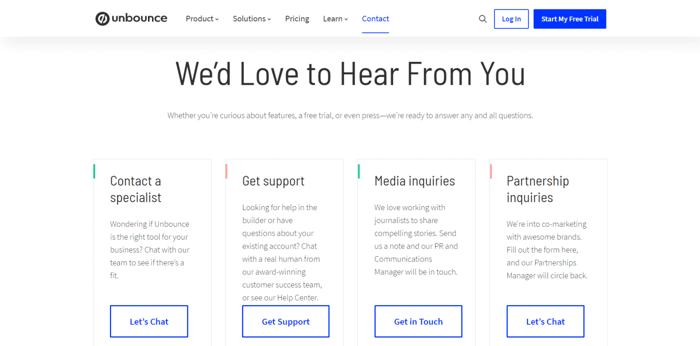
Whose Customer Support Is Better?
In the realm of customer support, Unbounce has a slight advantage. Based on the experiences of many users (check out the customer reviews on both page builders on G2.com and Capterra.com), it looks like the Instapage customer support team fails to satisfy users' expectations more often than the Unbounce customer support team. While Instapage gets mixed to overall good reviews, Unbounce has overall good reviews.
Over and Out
In this Instapage vs. Unbounce comparison, we explored how these landing page platforms perform in four different areas: pricing, features, integrations, and customer support. Although not short, we feel like this article barely scratched the surface of the Instapage vs. Unbounce topic. At the same time, we’d like to believe that it can serve as the basis for a better understanding of these platforms and help you choose the most suitable landing page platform for your business.


